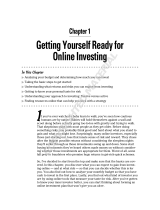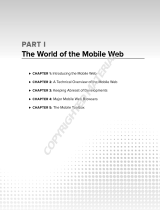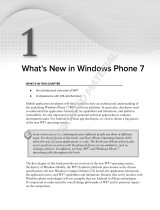Page is loading ...

INTRODUCTION
THEY ARE THE Appillionaires: Smart, ambitious dreamers in bedrooms
and garages across the world, plotting the future of mobile apps. eir
tools are inexpensive — a MacBook Pro and an iPhone — but overnight
the Appillionaires can amass a fortune from selling so ware on the iTunes
App Store. ey lead a revival of the hobbyist programmer. Not since the
days of the Commodore 64 and Atari 2600 has indie so ware been sold by
such tiny teams of programmers to such massive numbers of consumers.
e money ows to the Appillionaires even as they sleep. While they
dream their Angry Bird-dreams, invisible electronic transfers push money
into the Appillionaires’ bank accounts from App Stores in over 80 di erent
countries. As much as $250 million gets spent at the App Store in a single
month. Over 10 billion apps have been sold on the store to date and it’s
estimated that Apple has signed up at least 79,000 so ware publishers to
the iOS (iPhone and iPad operating system) club.
What’s remarkable is that Apple’s credibility was bolstered so much by the
success of the iPod and iPhone that the rise of the iPhone app was widely
predicted. Even before the launch of the App Store back in 2008, Wired
magazine speculated, “iPhone so ware development may spark a so ware
gold rush not seen since the heyday of PC-platform development in
the 1990s.”
1
04_9781119978640-ch01.indd 304_9781119978640-ch01.indd 3 8/30/11 11:56 AM8/30/11 11:56 AM
COPYRIGHTED MATERIAL

4
Appillionaires: Secrets from Developers Who Struck It Rich on the App Store
THERE’S GOLD IN THEM HILLS
It’s this label “gold rush” that has been most o en applied to the App Store.
e potential for success, and risk of failure, is so great that in many ways the
App Store has provoked a gold rush among developers. Although the
successes are spectacular, the failures are apocalyptic. e mainstream press
focuses on the glorious few and gives very little attention to the money being
lost on the App Store — a problem compounded by the embarrassed silence
of those struggling to turn a pro t on their work. In a climate where
approximately 540 apps are submitted for review every day, it’s easy to see
why the Appillionaires are an exclusive and rare breed.
Back in the 80s a catastrophic failure to sell so ware was a more obvious and
public humiliation. Take Atari’s E.T. the Extra-Terrestrial (1982), a failed
videogame which le the company with losses of over $100 million and the
embarrassing problem of what to do with 3.5 million unsold E.T. cartridges
(the answer, apparently, was to bury them in a New Mexico land ll). But
today such failures are even harder to see with the naked eye. For every
Appillionaire, there are several thousand invisible, failed app developers.
ese developers have had their dreams of app superstardom cruelly
smashed into a million little pixels. More humbling still is the realization
that, despite everything the App Store has done to democratize so ware
development, ultimately success may come from more unpredictable forces
than basic hard work. Most indie developers struggle to get any attention for
their apps — they simply don’t have the marketing clout of giant corpora-
tions and must rely entirely on their placement in the App Store. For many,
the only real chance of success is to be featured by Apple in one of the highly
desirable iTunes banner adverts.
As iPhone developer Sean Maher points out, “you can’t put ‘get
featured by Apple’ in your business plan any more than you can
put ‘win the lottery’ in your personal budget.”
e Appillionaires are engaged in trench warfare against each other, and
against the traditional publishers of corporate America’s vanguard. App
development has become a cut-throat industry where an increasing small
number of independent players battle it out for the attention of over 180
million iPhone and iPad owners, each of these owners downloading around
ve apps per month. e competition is so intense that the App Store is
scarred by the Appillionaire’s rivalry. Shills have been known to clog up their
rival’s apps with bad reviews on iTunes, while writing positive reviews for
their own apps. Apple’s Phil Schiller has gone as far as to remove a developer
04_9781119978640-ch01.indd 404_9781119978640-ch01.indd 4 8/30/11 11:56 AM8/30/11 11:56 AM

Chapter 1: Introduction
5
called Molinker from the App Store for cheating the reviews system by
positively rating its own apps. e end result was that Molinker had all of its
1,100 apps pulled from the store and was shamed globally by thousands of
blogs. Some developers have discovered shill reviews on their apps, traced
these back to rival companies, and phoned the CEO to ask why his head of
mobile marketing was writing reviews of competing apps.
Tensions between competitors are inevitable because the Appillionaires
ght it out in a crowded landscape of over 160,000 apps. It’s a place where
millions of dollars can be made or lost in an instant; where dropping o the
top-ten in the App Store means an exponential decline in sales, obscurity,
and even ruin. It’s a bizarre, upside-down chaos where venture capitalists
might spend millions on an app, only to discover themselves beaten to the
top spot in the App Store by a 15 year old armed with nothing more than a
Mac and a dog-eared copy of Objective-C For Dummies. e size of your
corporation and the scale of your investment can be outmatched simply
by the intellectual prowess of your competitor working out of his or her
bedroom.
APP STORE ROULETTE
Given its unpredictability, what makes the App Store so popular? One theory
is that we enjoy the strange psychological lure of uncertainty. Researchers
have discovered that we o en nd relationships more compelling if the
object of our a ection is mysterious and non-committal. e image of a girl
sat on a lawn picking petals from a ower and musing, “He loves me, he
loves me not” is a fairly accurate depiction of a developer’s relationship with
Apple. On one hand the girl with the ower hopes that “he” loves her, but on
the other hand a lot of the fun is down to not knowing. It’s human nature
that we are attracted to the thrill of never being quite sure where fortune will
smile, and there are few businesses where that feeling is more acute than iOS
development. Everything about the process is uncertain.
Developer Daniel Markham calls iPhone development “App Store Roulette,”
and Andy Finnell of the so ware studio Fortunate Bear cautions against
hoping for App Store success, “you’re betting a lot of this on luck, and the
odds are stacked against you. You’d have better odds playing slots at a
casino.”
Indeed, as much as app development has been called a gold rush, there is an
equally loud theory that it operates more like a casino.
04_9781119978640-ch01.indd 504_9781119978640-ch01.indd 5 8/30/11 11:56 AM8/30/11 11:56 AM

6
Appillionaires: Secrets from Developers Who Struck It Rich on the App Store
“ e closest thing I’ve seen to a ‘business model’ for marketing
iPhone apps is to advertise like crazy until you get into the top
50,” says David Barnard of AppCubby, “once you’re there, the top
50 list will start generating its own buzz… But that’s not a
business model, that’s like rolling the dice at a casino.”
e counter-argument is that life itself is hard, very much like rolling a dice
at times. It might be that the App Store simply gives developers the illusion
of an ordered system, with top-ten lists and sales tracking, but ultimately it is
human nature and the unpredictable whim of the masses that determine the
success of an app. e App Store might look like an ordered system, but
really it’s just a layer over the messy reality of selling anything.
CHALLENGES WITH THE APP STORE
e App Store does present some unusual problems though. For one: the
sheer number of apps available. Craig Hockenberry, who made the popular
iPhone app Twitteri c, complained as early as 2008 that a race to the bottom
on prices meant his team could not invest time and money in great apps.
“We have a lot of great ideas for iPhone applications,” said Hockenberry,
“Unfortunately, we’re not working on the cooler (and more complex) ideas.
Instead, we’re working on 99¢ titles that have a limited lifespan and broad
appeal. Market conditions make ringtone apps most appealing.”
But in the intervening years, the 99¢ price has not won out completely. App
developers 2D Boy sold more than 125,000 copies of World of Goo for the iPad
priced at $4.99 in just two months and several best-selling iPad book apps have
also skirted $9 or more. Developers sometimes attempt to make money simply
by selling enough apps at the cheapest possible price, but this isn’t always the
best plan. O en a lower price just invites a torrent of abusive reviews from
younger, more ippant users who take a chance on an app they don’t really
want. Still, deciding what to charge for an app remains a strange art, and only
adds to the curious reverence many of us feel towards the Appillionaires.
e App Store is also unusual and unpredictable because it’s a hugely
signi cant distribution method for the creative arts, but it’s controlled by a
single all-powerful god: Apple Inc. e company decides what is and isn’t
allowed to be sold in the App Store. Although critics like those who work for
e New York Times initially warned that Apple’s censorship of apps would
“discourage [developers] from spending nights and weekends working on
new and useful applications,” in the end it seems to have had little e ect other
than to reassure consumers and generate even more publicity for the iPhone
and iPad.
04_9781119978640-ch01.indd 604_9781119978640-ch01.indd 6 8/30/11 11:56 AM8/30/11 11:56 AM

Chapter 1: Introduction
7
World of Goo in action. This deliciously addictive physics puzzler has sold millions
of copies.
SOURCE: Copyright 2D Boy Ltd.
Since the opening of the App Store there have been a litany of complaints
and high-pro le criticism of Apple’s policies. ese reached a crescendo
when Trent Reznor of the band Nine Inch Nails reacted to a rejection notice
from Apple on the grounds that his app “contains objectionable content.” In
reply Reznor wrote, “ anks Apple for the clear description of the problem -
as in, what do you want us to change to get past your stupid standards?”
Apple accepted the app a few days later, refusing to comment on what had
changed its mind.
04_9781119978640-ch01.indd 704_9781119978640-ch01.indd 7 8/30/11 11:56 AM8/30/11 11:56 AM

8
Appillionaires: Secrets from Developers Who Struck It Rich on the App Store
THE APP COMMUNITY
In the midst of all this confusion and competition, there are also stories of
great friendship and, o en, a wonderful sense of camaraderie among the
Appillionaires. e community of people behind the apps you use on your
iPhone and iPad are uniquely creative and communicative, o en building
extremely close friendships with other app makers. Take characters like Mills
from ustwo, the self-styled “King of Failure,” and a Twitter superstar who
takes as much pride in his app disasters as his successes. Mills is the closest
thing the industry has to a cultural barometer, providing a constant stream
of consciousness direct from the mind of a leading app developer. To read
his Twitter feed is to witness rst-hand the turmoil in the soul of an
Appillionaire. As his company’s apps dri wildly in and out of the top ten,
his tweets tread a spectrum of emotion, from the heartwarming advice,
“make love… not code,” to, later in the day, simply, “I give up.”
Nursery Rhymes with Storytime is Mill’s most successful indie app to date.
SOURCE: Copyright ustwo Ltd and Atomic Antelope Ltd.
04_9781119978640-ch01.indd 804_9781119978640-ch01.indd 8 8/30/11 11:56 AM8/30/11 11:56 AM

Chapter 1: Introduction
9
is book is also going to introduce you to the smaller teams, like Johnny
Two Shoes: Two brothers, Max and Scott Slade, who created the indie pirate
romp, Plunderland, an app that allowed them to drop out of the nine-to- ve
slog and embark on a philosophical adventure, punctuated by late-night
coding binges. “I just get to do what I want to do now,” says Max, who made
over $16,000 a day at the height of Plunderland’s success.
The smash hit pirate-themed caper, Plunderland, created by Max and Scott Slade.
SOURCE: Copyright Johnny Two Shoes Ltd.
With an appetite for glory coupled with 24-hour access to the Internet,
relationships are strong in this industry. e Appillionaires are sometimes
friends and o en relatives. ey may even be husband and wife, like the
04_9781119978640-ch01.indd 904_9781119978640-ch01.indd 9 8/30/11 11:56 AM8/30/11 11:56 AM

10
Appillionaires: Secrets from Developers Who Struck It Rich on the App Store
team behind Harbor Master, who you’ll revisit later in this book. ey
eschew all traditional visions of the storefront; Appillionaires work from
garages, bedrooms, and cafés, and then distribute their creations
electronically.
THE SIREN CALL
Perhaps more fascinating than the Appillionaires themselves is the mystery
and allure surrounding the app business. It’s become a siren call for thou-
sands and thousands of amateur programmers and designers intent on living
the App Store dream and becoming an overnight millionaire. One thing that
stood out as I interviewed the app makers in this book: O en they discov-
ered that complete strangers would stop and pitch them app ideas. Just as
doctors nd people asking them for medical diagnosis at a party, the app
makers o en nd themselves in the middle of impromptu pitching sessions.
“I get pitched app ideas all the time. I got a phone call from a friend
yesterday,” explains Mills. “He said to me: ‘You’re an app man, I’ve got an
idea for an app. I just don’t know what to do. Should I patent it?’,” Mills sighs.
“I said, ‘What idea have you got?’ en he told me he wanted to go half-and-
half. So, I would make the app based on his idea and he’d make half the
money.” Mills slams the table with his st in anger. “I couldn’t even answer
him. What’s the point?” Mills is clearly a man who has been pitched apps
way beyond his tolerance point.
It seems that no sooner does a developer mention that he or she is in the app
business than a crowd gathers and starts pitching app ideas, or asking how
much he or she has made on the store. In this sense, the App Store increas-
ingly does resemble a gold rush. It might be this overwhelming popular
ambition to create apps that has caused a cynicism to take root. Tristan
Celder, whose company, Zolmo, created the phenomenally successful Jamie
Oliver 20 Minute Meals app, represents a growing number of developers
who think that the gold rush is now largely a myth — perpetuated by the
very developers who appear to be the richest.
“ ere’s a lot of hype surrounding apps that Google and Apple are very good
at manufacturing,” explains Celder. “To be Apple’s App of the Week looks like
a stream of gold, but doesn’t always come to fruition. ere’s a lot of young
companies — start-ups — that are trying to in ate their own value to get
investors, so they’re happy for that hype to be there. But whenever someone
isn’t releasing download numbers, you have to wonder what’s really going on.”
04_9781119978640-ch01.indd 1004_9781119978640-ch01.indd 10 8/30/11 11:56 AM8/30/11 11:56 AM

Chapter 1: Introduction
11
WHY I WROTE APPILLIONAIRES
As you prod deeper into the world of the Appillionaires, the water gets
increasingly murky, and that’s precisely the reason I set out to write this
book. Many of the people I’ve interviewed for Appillionaires have expressed
confusion about the reality of the App Store, despite their massive successes.
First, this book sets out to answer the biggest question on the technology
scene today — What does it take to make a million dollars on the App Store?
However, I also wanted to discover more about the other side of the App
Store: ose who have struggled to nd success.
It’s this other side to the Appillionaire story that is almost more intriguing:
e strange disparity between the amount of money actually made on the
App Store and the public perception of the App Store as a goldmine. I
wanted to discover, rst-hand, if the Appillionaire dream was as widely
realized as it appears to be. And, if it is indeed a rarity, how has the illusion
of probable success been so widely and e ectively spread by the mainstream
media?
is impression of easy riches has been bolstered by newspapers and
magazines, which seem to lap up every minor App Store success story with a
mesmerizing eagerness. Apps have gone mainstream, pop-culture even: e
masses have heard the apocryphal tales, the rags-to-riches stories, and they
want to live the dream too. ey wear Angry Bird T-shirts, and they tell each
other increasingly ridiculous stories about the lavish houses of the program-
mer who built the wildly successful iShoot app. ey draw game plans for
world domination using Sketchbook on their iPads. But what is o en
forgotten, in the telling of these capitalist parables, is that few Appillionaires
were true overnight successes.
As Mills tells me of Angry Birds, “People say it was an overnight
success. Well, yes, it was an overnight success a er 52 other failed
attempts.”
WHERE WILL THE MARKET TAKE US?
en there is the new wave of app makers. ey’re thinking bigger and
they’re better nanced — some might say ridiculously nanced. Apps like
Color, which cost $41 million to launch, shocked the industry by demon-
strating just how much raw cash investors were willing to throw at the
mirage, but it was just the beginning. By April, the creators of an iPad app
04_9781119978640-ch01.indd 1104_9781119978640-ch01.indd 11 8/30/11 11:56 AM8/30/11 11:56 AM

12
Appillionaires: Secrets from Developers Who Struck It Rich on the App Store
called Flipboard, a “social magazine,” had managed to raise an investment
of $50 million — valuing the company at $200 million. It’s a staggering
amount. Flipboard is a free app and though it dances around the very top of
the iPad chart, at the time of writing it provides no tangible income for the
company that built it. More worriesome still (for those that fear an app
bubble is growing) is the justi cation for this enormous sum. Flipboard’s
CEO, Mike McCue, appeared to be channeling the venture capitalists who
backed him when a journalist asked how the company could possibly need
or want that much money.
Color, the most costly iPhone app built so far. It took a $41 million investment to
launch the software. At the time of writing it has sunk down though the charts and
user reviews of the app average two stars out of a possible ve.
SOURCE: Copyright Color Inc.
04_9781119978640-ch01.indd 1204_9781119978640-ch01.indd 12 8/30/11 11:56 AM8/30/11 11:56 AM

Chapter 1: Introduction
13
“We decided the only way you could get to a multi-billion dollar business is
through advertising. So given that, to build an advertising business, you’ve
got to have a lot of scale. You’ve got to build a consumer brand, acquire tens
of millions of users,” McCue told TechCrunch in spring 2011.
is is the kind of language the app industry is beginning to use more and
more o en. e CEOs themselves have begun to echo the standard VC
(venture capitalist) mantra to build it bigger and bigger, faster and faster.
e VCs favorite word is scale, and although the tech industry has always
attracted a legion of the wealthy and bewildered, the App Store has
drummed up a mass of investment unseen since the dotcom boom. e
Appillionaires have, through their success, spawned a climate where VCs
circle greedily. In meetings with them, you can almost see the dollar signs
spinning in their eyes. Armed with hedge-fund capital, and fresh from their
MBA, they are the pinstriped wildebeest hunting for e Next Big ing.
Max Slade from Johnny Two Shoes remembers the initial attack from VCs well.
A er the success of Plunderland, he had to take urgent action to fend them o .
“We actually unplugged our phone because we were getting so many calls
from VCs saying, “We want to give you some money; let’s give you some
money. Here, have some money. Money. Money!” Slade tells me. He then
mimes a grinning lunatic throwing out bundles of cash. Oddly, this is
possibly the most accurate depiction I’ve witnessed of how investors react to
an App Store success story. In the end, Slade declined to accept any VC cash.
is book also serves as an exposé of the app VCs and the people they hunt,
desperate to invest their cash in the early stages of a your dream. ey’re
eager to talk to young hopefuls like Andrew Lim who is, like me, a former
journalist turned app developer.
Lim is trying to get venture capitalists interested in his new app idea. When I
rst asked him what his idea was he told me, “I’m making the next Face-
book. Facebook Two, basically.” He then burst into laughter. I told Lim it was
possibly the least-convincing pitch I’ve ever heard.
“I’ve been talking to investors and I haven’t been to a single pitch where I
haven’t burst out laughing or they haven’t burst out laughing,” Lim
explained. “It is madness, but there’s a small window of opportunity to make
an impact. You’ve got crazy people coming into the app scene, there’s
ridiculous money out there and there’ll be a crash. But there will also be a
second spike, where it’s all more re ned.”
04_9781119978640-ch01.indd 1304_9781119978640-ch01.indd 13 8/30/11 11:56 AM8/30/11 11:56 AM

14
Appillionaires: Secrets from Developers Who Struck It Rich on the App Store
THE BAND OF DREAMERS
In this book, you’ll going to meet the rich, famous, and eccentric of the app
development world. is unlikely band of dreamers includes the two
brothers from Croatia who have sold over 10 million copies of Doodle Jump.
e husband and wife team from Washington DC who made a fortune with
their $1.99 app, Harbor Master. e studio behind Angry Birds, whose
blockbuster app now looks likely to become a Hollywood feature lm. And
the makers of Pocket God and other smash-hit apps. You’ll hear directly from
these visionaries and learn their secrets rst-hand. It’s a weird and wonderful
land where bedroom coders turn into millionaires overnight. Where
teenaged code-monkeys irt with venture capital and the good die young,
iPhones in hand.
Cut the Rope is just one of many iOS success stories. It sold over one million copies
just nine days into its release.
SOURCE: Copyright Chillingo Ltd.
04_9781119978640-ch01.indd 1404_9781119978640-ch01.indd 14 8/30/11 11:56 AM8/30/11 11:56 AM

Chapter 1: Introduction
15
In this book you’re also going to meet the underdogs. e broken-hearted,
the failures, and the disasters.
e rise of the app has massively altered the public perception of what a
so ware programmer is. It’s turned a generation of geeks from social mis ts
into superheroes. Mention to someone that you make iPhone apps and their
interest will pick up instantly. ey may even ask if you’re a millionaire. is
is an astonishing change from what a programmer in the 80s could have
expected in reaction to their job description. We now live in an age where
companies like Tapulous can, apparently without irony, run a job ad that
reads, “We are hiring rock-star developers.” Amazingly, if you visit a modern
development studio, you may nd that the workers are treated a bit like rock
stars. e demand for good programmers has never been greater and this is
re ected in the perks being o ered to entice them to new start-ups.
SUMMARY
A good iPhone programmer is rare and much in demand. e geek-kings
you’ll learn about in this book have become increasingly aware of their
value. e Appillionaires have encouraged a new breed of programmers,
born in their image, who are edging toward the golden days of the dotcom
bubble — a time when technology geniuses could entrance docile investors
with promises of glory. Riding around your Soho lo on a kid’s plastic
tricycle while the head of marketing squirts you with a water pistol has
become socially acceptable again. We live in crazy times.
Here’s a roundup of the important points covered in this chapter:
n e cost of playing the Appillionaire game is theoretically low. It’s just
$99 to join up as an Apple developer. e real expense is the investment
of your time, or paying people’s salaries.
n Over $250 million is spent at the Apple App Store every month. And it’s
just the start. e mobile so ware industry is witnessing explosive
growth.
n Even successful developers recognize an element of luck is involved in
building a hit app. ere are few guarantees.
n Apple has complete editorial control over what goes on the App Store.
e Appillionaires have to work within the bounds of what Apple
considers acceptable material for sale, both technically and morally.
04_9781119978640-ch01.indd 1504_9781119978640-ch01.indd 15 8/30/11 11:56 AM8/30/11 11:56 AM

16
Appillionaires: Secrets from Developers Who Struck It Rich on the App Store
n Hysterical venture capitalists are investing huge amounts of money into
the app scene right now. ere couldn’t be a better time to seek
investment for your grand scheme. Just make sure you have a back-up
plan in case things turn apocalyptic — they probably will.
Now you know the basic geography of the Appillionaire’s universe, let’s take
a trip through the door of the world’s most mysterious, alluring, and
nonsensical shop: e Apple App Store.
04_9781119978640-ch01.indd 1604_9781119978640-ch01.indd 16 8/30/11 11:56 AM8/30/11 11:56 AM
/










